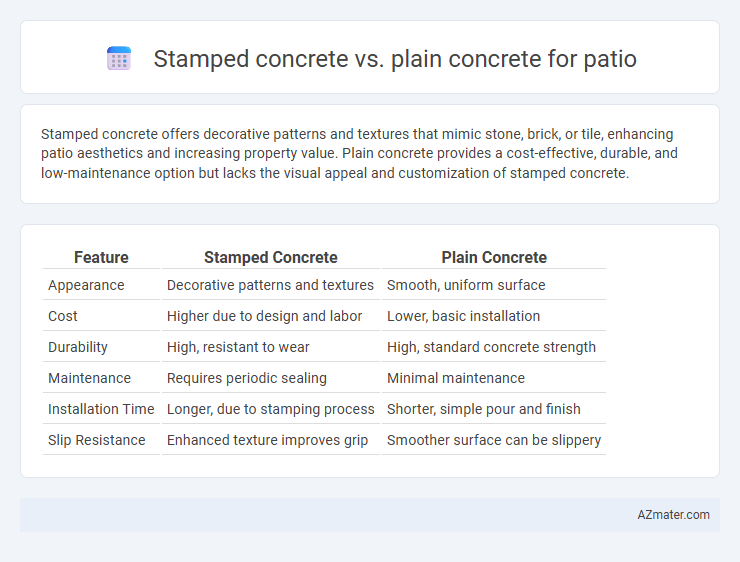Stamped concrete offers decorative patterns and textures that mimic stone, brick, or tile, enhancing patio aesthetics and increasing property value. Plain concrete provides a cost-effective, durable, and low-maintenance option but lacks the visual appeal and customization of stamped concrete.
Table of Comparison
| Feature | Stamped Concrete | Plain Concrete |
|---|---|---|
| Appearance | Decorative patterns and textures | Smooth, uniform surface |
| Cost | Higher due to design and labor | Lower, basic installation |
| Durability | High, resistant to wear | High, standard concrete strength |
| Maintenance | Requires periodic sealing | Minimal maintenance |
| Installation Time | Longer, due to stamping process | Shorter, simple pour and finish |
| Slip Resistance | Enhanced texture improves grip | Smoother surface can be slippery |
Introduction to Stamped and Plain Concrete Patios
Stamped concrete patios feature textured patterns and colors that mimic natural stone, brick, or wood, offering enhanced aesthetic appeal and design versatility. Plain concrete patios provide a smooth, minimalist surface known for durability, low maintenance, and cost-effectiveness. Both options serve as functional outdoor living spaces, with stamped concrete emphasizing decorative customization and plain concrete prioritizing simplicity and practicality.
Aesthetic Differences: Visual Appeal and Customization
Stamped concrete for patios offers enhanced aesthetic appeal through intricate patterns and textures that mimic natural stone, brick, or tile, providing a customizable and visually striking surface. Plain concrete, with its uniform gray appearance, lacks the decorative options but serves as a versatile and minimal backdrop for various outdoor designs. The ability to incorporate color, embossing, and diverse finishes in stamped concrete allows homeowners to create a unique, high-end look that plain concrete cannot achieve.
Installation Process: Stamped vs Plain Concrete
Stamped concrete installation involves pouring a concrete slab followed by pressing textured molds into the wet surface to create decorative patterns, requiring precise timing and skilled labor to achieve optimal texture and color effects. Plain concrete installation is more straightforward, consisting of pouring and leveling concrete without additional surface treatments, making it quicker and generally less expensive. Both methods require proper curing and sealing, but stamped concrete demands closer attention during the finishing phase to preserve its intricate designs.
Cost Comparison: Which is More Budget-Friendly?
Stamped concrete typically costs between $8 and $18 per square foot due to its intricate designs and texture, while plain concrete averages $3 to $7 per square foot, making it more budget-friendly for large patios. The added labor and materials for stamping increase upfront expenses but can enhance property value and aesthetics. Choosing plain concrete reduces immediate costs with simpler installation but may lack the decorative appeal of stamped options.
Durability and Longevity: Performance Over Time
Stamped concrete offers enhanced durability for patios due to its textured surface, which resists cracking and wear better than plain concrete. The integrated color and sealants in stamped concrete protect against weathering and fading, extending its lifespan beyond that of standard plain concrete. While plain concrete is prone to surface erosion and requires more frequent maintenance, stamped concrete consistently maintains both structural integrity and aesthetic appeal over time.
Maintenance Requirements: Ease of Care
Stamped concrete requires regular sealing every 2-3 years to maintain its color and prevent cracking, whereas plain concrete demands fewer coatings but may need more frequent cleaning to avoid stains and discoloration. Both surfaces benefit from periodic washing and prompt removal of debris, yet stamped concrete's textured surface can trap dirt more easily than the smooth plain concrete. Proper maintenance extends the lifespan of either patio type, with stamped concrete offering enhanced aesthetic appeal but slightly higher upkeep.
Slip Resistance and Safety Considerations
Stamped concrete offers enhanced slip resistance due to its textured surface patterns that mimic natural stone or brick, providing better traction compared to the smooth finish of plain concrete. The added grip reduces the risk of slips and falls, making it a safer choice for patios, especially in wet or poolside environments. Plain concrete, while more affordable, can become slippery when wet and may require additional treatments like sealers or anti-slip additives to improve safety.
Weather and Climate Impact on Concrete Patios
Stamped concrete offers enhanced durability and better resistance to temperature fluctuations and moisture compared to plain concrete, making it ideal for patios in variable climates. Its textured surface improves traction, reducing the risk of slipping during wet or icy conditions, which is critical in areas with frequent precipitation or frost. Plain concrete may suffer more from cracking and surface damage due to freeze-thaw cycles, decreasing its longevity and increasing maintenance needs in harsh weather environments.
Resale Value: Which Option Increases Home Value?
Stamped concrete enhances patio aesthetics by mimicking natural stone or brick, significantly boosting curb appeal and increasing home resale value by up to 10%. Plain concrete offers durability and low maintenance but lacks the visual impact that draws potential buyers' interest. Investing in stamped concrete creates a more attractive outdoor living space, making the property more appealing and likely to fetch a higher market price.
Choosing the Right Concrete Patio for Your Needs
Stamped concrete offers enhanced aesthetic appeal with customizable patterns and colors, making it ideal for patios where design and texture are priorities. Plain concrete provides a cost-effective and durable solution, suitable for functional outdoor spaces requiring low maintenance and longevity. Assessing your budget, desired appearance, and maintenance willingness will guide the choice between stamped and plain concrete for your patio project.

Infographic: Stamped concrete vs Plain concrete for Patio
 azmater.com
azmater.com